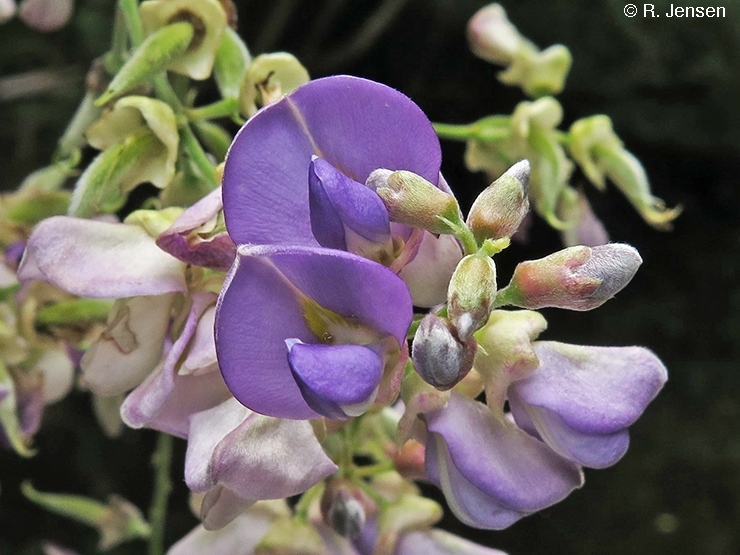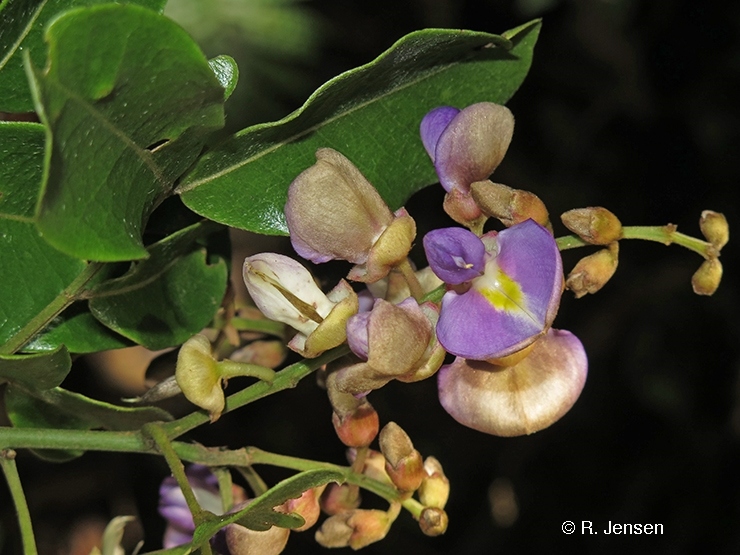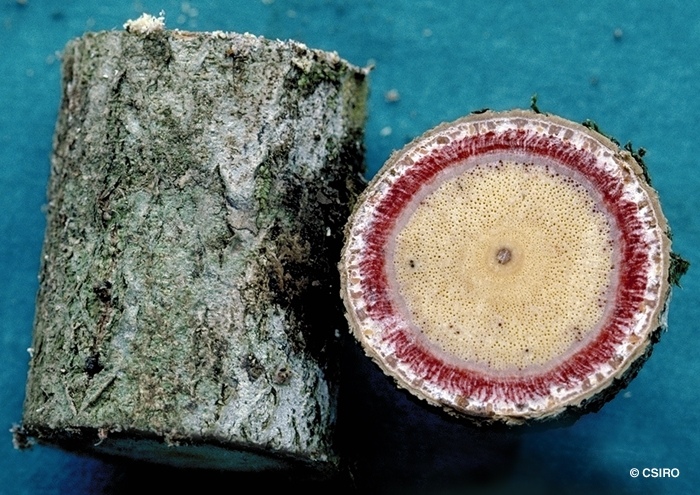Australian Tropical Rainforest Plants - Online edition
Austrocallerya australis (Endl.) J.Compton & Schrire





Compton, J.A. et al (2019) Phytokeys 125: 86-88.
Blunt Wistaria; Samson's Sinew
Vine stem diameters to 20 cm recorded; bark grey or cream, rough with shallow longitudinal or diagonal striations or a crosshatched pattern and usually marginally and thinly flaky at edges of patterning. Exudate rather slow to appear. Stipules persistent or caducous, ovate or narrowly triangular, 1.25-4 mm long and 0.25-2 mm wide at base, sericeous to glabrescent.
Leaf rachis + petiole channelled on upper side, 18-220mm long, pubescent or sericeous; pulvinus 4-12mm long, 1.25-3mm wide, sericeous or pubescent, hairs denser than remainder of the petiole; lateral petiolules 1-4 mm long, pubescent to glabrescent; stipels persistent or caducous, filiform or triangular, 1-4 mm long, sericeous; leaflets 5-19, discolorous, elliptical, narrowly elliptical, narrowly ovate, oblong or obovate, 10-86 mm long, 5-45 mm wide, leathery, upper side shiny, both sides with a few sparse prostrate or erect hairs denser along primary vein and margin and becoming sparse elsewhere; underside may be shiny, glabrescent; both sides with prostrate hairs denser along primary vein and margin; base cuneate, truncate, obtuse or rounded; apex acute, obtuse or very shortly acuminate (rarely truly acuminate) narrowing to obtuse, retuse or emarginate; margin entire, often undulate, narrowly recurved and often scarious; primary vein +/-flush on upper side in dried specimens, distinctly raised on underside, drying pale coloured (or blackish on Mount Bartle Frere specimens); secondary veins 7-12 pairs, flush or slightly raised on both surfaces, angle of divergence from primary vein 20-40 degrees, forming loops 1-4 mm from margin.
Inflorescence a panicle 60-260 mm long; rachis shortly sericeous or pubescent; branches 30-120 mm long; brachyblasts absent or <1 mm long; bracts at base of pedicel caducous, narrowly triangular, filiform or ovate, 1.5-4 mm long, 0.5-1 mm wide at base, sericeous; pedicels 3-11 mm long, sericeous or puberulent; bracteoles caducous, filiform or triangular, 1.25-2.75 mm long and ~0.5 mm wide at base, sericeous. Flowers: fragrance not detected; calyx 3.5-7 mm long, 5-10 mm wide, yellowish or yellow-green, sometimes with purple markings, glabrous adaxially or a few hairs near margin; standard orbicular to broadly orbicular, 12-15 mm long (including claw 2-3 mm long) and 11-18 mm wide, mauve, purple or whitish, often with a whitish margin and yellow or limegreen nectar guides in the centre, pitted glands often present on the nectar guides, abaxially sericeous and adaxially glabrous except for a few hairs near apex; base obtuse, cordate or truncate; apex emarginate and distinctly hooded (often with a minute spur in the cleft), margin often inrolled along sides and apex; wings 12-14 mm long (including claw 1.5-3 mm long), 5-5.5 mm wide, purple or maroon, glabrous, base cordate; upper margin entire but maybe inrolled; auricle falcate or flabellate, apex folded, entire or 2- or 3-toothed, 1-2 mm long and 0.75 mm wide, glabrous; lower margin ciliate; keel 12-14 mm long (including claw 2-4 mm long), 5-6 mm wide; purple or maroon, glabrous; upper margin ciliate in basal half, auricle obtuse or triangular, 0.25-1 mm long and 0.5-0.75 mm wide, lower margin ciliate; stamens up to 12 mm long, glabrous; disc distinct or indistinct, shortly tubular (or not tubular, in the population at Mount Bartle Frere), tube apex crenate, sinuate, lobed or shallowly toothed; ovary fusiform, shortly stipitate, 8-12 mm long and 1.25-2mm wide, sericeous, stipe ca. 1mm long; style glabrous or sparsely hairy at base; ovules 3-12.
Fruit: pedicel 6-15 mm long, thickened; pod woody, dehiscent or indehiscent, dehisces and rots after falling, cylindrical, torulose, tapered at both base and apex, constricted between seeds, slightly thickened along suture line, 70-230 mm long and 30-44.5 mm wide, brown, grey or blackish, epicarp shallowly and finely ribbed, glabrous; pericarp 5-7 mm wide, mesocarp pithy with a chartaceous inner wall; seeds 1-6, triangularorbicular, oblate, squarish, globose or angular, 12-24 x 12-22 x 12-20 mm, reddish, dull red, reddish-brown, tan, burnt-orange or rusty-red; hilum 21-23 mm long. Germination hypogeal. Cotyledons +/- fused together.
Numerous (about 15) cataphylls produced before the first pair of true leaves. First three true leaves trifoliolate, subsequent leaves pinnate with five to seven leaflets. At the tenth leaf stage: leaflet blades elliptic, apex acute, base cordate, terminal leaflet larger and on a larger stalk than the lateral leaflets. Leaflets mainly glabrous except for the midrib which is hairy on both the upper and lower surfaces and raised on the upper surface. Stipules hairy, linear, about 2.5 mm long. Stipels absent. Seed germination time 23 to 28 days.
Endemic to Australia, occurs in NEQ, on Norfolk Island and in south-eastern Queensland and north-eastern New South Wales. Altitudinal range in NEQ from near sea level to 800 m. In NEQ occurs in two separate and different habitats: one is in simple notophyll rainforest on the western side of Mount Bartle Frere; the second site is along the banks of the Daintree River and its tributary Barratt Creek at or just above the high-tide zone in a habitat of mixed mangrove and rainforest species where wet-season floods inundate the area.
Pterocarpus australis Endl., Prodromus Florae Norfolkicae: 94 (1833), Type: "Crescit in insula Norfolk, mense Octobri florens. (Ferd. Bauer.)" Text: "Ferd. Bauer Illust. pl. Norfolk t. 149." Millettia australis (Endl.) Benth., Leguminosae. Plantae Junghuhnianae 2: 250 (1852). Wisteria australis (Endl.) F.Muell., Systematic Census of Australian Plants Suppl. 2: 3 (1885). Callerya australis (Endl.) Schot, Blumea 39(1/2): 16 (1994). Millettia maideniana F.M.Bailey, Botany Bulletin. Department of Agriculture, Queensland 5: 12 (1892), Type: "Port Macquarie, communicated by Mr. J.H. Maiden." Wisteria maideniana (F.M.Bailey) C.Moore, Handbook of the Flora of New South Wales: 517 (1893). Callerya sp. Barratt Creek (G.Sankowsky 428) [Provisional HISPID Phrase Name]





